Kidney Structure Study guides, Class notes & Summaries
Looking for the best study guides, study notes and summaries about Kidney Structure? On this page you'll find 8239 study documents about Kidney Structure.
All 8.239 results
Sort by
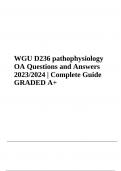 Popular
Popular
-
WGU D236 pathophysiology: Objective Assessment Questions and Verified Answers | Latest 2023/2024 GRADED A+
- Exam (elaborations) • 71 pages • 2023
-
- $22.49
- 10x sold
- + learn more
WGU D236 pathophysiology: Objective Assessment Questions and Verified Answers | Latest 2023/2024 GRADED A+. A major function of potassium is to conduct nerve impulses in muscles. Too low and muscle weakness occurs and too much can cause muscle spasms. This is especially dangerous in the heart muscle and an irregular heartbeat can cause a heart attack The body uses the Protein Buffering System, Phosphate Buffering System, and Carbonic AcidBicarbonate System to regulate and maintain homeostatic...

-
Test Bank for Porth's Essentials of Pathophysiology 5th Edition by Tommie L Norris ISBN-13: 9781975107192 |COMPLETE TEST BANK| Guide A+
- Exam (elaborations) • 421 pages • 2023 Popular
- Available in package deal
-
- $12.99
- 10x sold
- + learn more
Porth's Essentials of Pathophysiology 5th Edition Test Bank ISBN-10:5 ISBN-13:7192 Table of Contents UNIT 1 - Concepts of Health and Disease Chapter 1— Concepts of Health and Disease UNIT 2 - Cell Function and Growth Chapter 2 — Cell and Tissue Characteristics Chapter 3 — Cellular Adaptation, Injury, and Death Chapter 4 — Genetic Control of Cell Function and Inheritance Chapter 5 — Genetic and Congenital Disorders Chapter 6 — Neoplasia UNIT 3 - Disorders of Integrative Function Chapt...
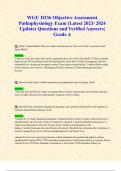
-
WGU D236 Objective Assessment Pathophysiology Exam (Latest 2023/ 2024 Update) Questions and Verified Answers| Grade A
- Exam (elaborations) • 30 pages • 2023
-
Available in package deal
-
- $10.99
- 5x sold
- + learn more
WGU D236 Objective Assessment Pathophysiology Exam (Latest 2023/ 2024 Update) Questions and Verified Answers| Grade A Q: What is Spina Bifida? Why are relative deficiencies in Folic acid or B12 associated with Spina Bifida? Answer: Failure to close the neural tube early in gestation due to low folic acid and B-12 These vitamins help activate DNA synthesis in the developing fetus in the first 4 weeks of pregnancy, that are responsible for closing up the spinal column. Three types of spina...

-
Test Bank For Porth's Essentials of Pathophysiology 5th Edition by Tommie Norris 9781975107192 Chapter 1-52 Complete Guide.
- Exam (elaborations) • 663 pages • 2022
-
- $26.90
- 8x sold
- + learn more
Test Bank For Porth's Essentials of Pathophysiology 5th Edition by Tommie Norris 7192, 5, 1812, X 1 Concepts of Health and Disease 2 Cell and Tissue Characteristics 3 Cellular Adaptation, Injury, and Death 4 Genetic Control of Cell Function and Inheritance 5 Genetic and Congenital Disorders 6 Neoplasia 7 Stress and Adaptation 8 Disorders of Fluid, Electrolyte, and Acid–Base Balance 9 Inflammation, Tissue Repair, and Wound Healing 10 Mechanisms of Infectious Disea...

-
Test Bank for Porth's Essentials of Pathophysiology 5th Edition by Tommie L Norris ISBN-13: 9781975107192 |COMPLETE TEST BANK| Guide A+.
- Exam (elaborations) • 660 pages • 2022
-
- $26.44
- 39x sold
- + learn more
Porth's Essentials of Pathophysiology 5th Edition Test Bank ISBN-10:5 ISBN-13:7192 Table of Contents UNIT 1 - Concepts of Health and Disease Chapter 1— Concepts of Health and Disease UNIT 2 - Cell Function and Growth Chapter 2 — Cell and Tissue Characteristics Chapter 3 — Cellular Adaptation, Injury, and Death Chapter 4 — Genetic Control of Cell Function and Inheritance Chapter 5 — Genetic and Congenital Disorders Chapter 6 — Neoplasia UNIT 3 - Disorders of Integrativ...
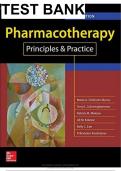
-
TEST BANK for Pharmacotherapy Principles and Practice 5th Edition Chisholm-Burns Test Bank. ALL 102 CHAPTERS (Complete Download).
- Exam (elaborations) • 344 pages • 2023
-
- $12.99
- 7x sold
- + learn more
Pharmacotherapy Principles and Practice 5th Edition Chisholm-Burns Test Bank ISBN10: 6 ISBN: 9445 Table of Contents : 1.Introduction 2. Geriatrics 3. Pediatrics 4. Palliative Care Part II Disorders of Organ Systems Section 1 Cardiovascular Disorders 5. Hypertension 6. Heart Failure 7. Stable Ischemic Heart Disease 8. Acute Coronary Syndromes 9. Arrhythmias 10. Venous Thromboembolism 11. Stroke 12. Dyslipidemias 13. Hypovolemic Shock Section 2 Respiratory Disorders 14. Asthma 15. Chronic Obstruct...

-
Test bank Porth's Essentials of Pathophysiology 5th Edition
- Exam (elaborations) • 557 pages • 2023
-
- $19.99
- 3x sold
- + learn more
Practice questions to help you better test and understand the material for your nursing exams and homework. Includes every chapter with questions, answers and rationales. Immediate download. Porth's Essentials of Pathophysiology 5th Edition Test Bank Table of Content UNIT 1 - Concepts of Health and Disease Chapter 1 Concepts of Health and Disease UNIT 2 - Cell Function and Growth Chapter 2 Cell and Tissue Characteristics Chapter 3 Cellular Adaptation, Injury, and Death Chapter 4 Genetic Control...
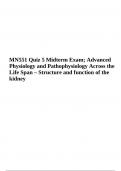
-
MN 551 MIDTERM EXAM 5 – QUESTION AND ANSWERS
- Exam (elaborations) • 14 pages • 2023
- Available in package deal
-
- $18.00
- 2x sold
- + learn more
MN 551 MIDTERM EXAM 5 – QUESTION AND ANSWERS Advanced Physiology and Pathophysiology Across the Life Span – Structure and function of the kidney
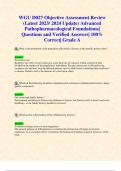
-
WGU D027 Objective Assessment Review (Latest 2023/ 2024 Update) Advanced Pathopharmacological Foundations| Questions and Verified Answers| 100% Correct| Grade A
- Exam (elaborations) • 62 pages • 2023
-
Available in package deal
-
- $11.49
- 3x sold
- + learn more
WGU D027 Objective Assessment Review (Latest 2023/ 2024 Update) Advanced Pathopharmacological Foundations| Questions and Verified Answers| 100% Correct| Grade A Q: What is the proportion of the population affected by a disease at the specific point in time? Answer: Prevalence rate - Incidence rate refers to how many new cases there are of a disease within a period of time divided by the number of the population's individuals. The prevalence rate is affected by the incidence rate and ...
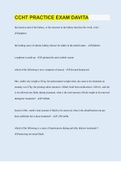
-
CCHT PRACTICE EXAM DAVITA | 150 Questions with 100% Correct Answers | Verified | Latest Update
- Exam (elaborations) • 19 pages • 2023
- Available in package deal
-
- $12.49
- 5x sold
- + learn more
the function unit of the kidney, or the structure in the kidney that does the work, is the - nephron the leading cause of chronic kidney disease for adults in the united states: - diabetes a nephron is made up - a glomerulus and a tubule system which of the following is not a symptom of uremia - elevated hematocrit Mrs. smith's dry weight is 62 kg. her pretreatment weight when she came in for treatment on monday was 67kg. the priming saline amount is 240ml, fluid from medication is 100 ml...

How did he do that? By selling his study resources on Stuvia. Try it yourself! Discover all about earning on Stuvia


